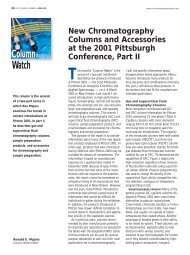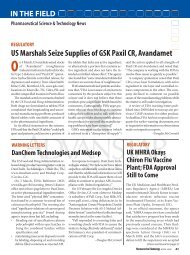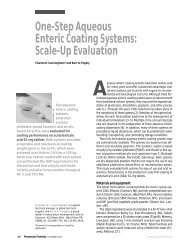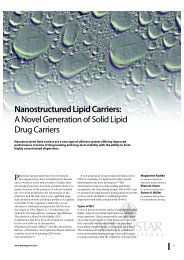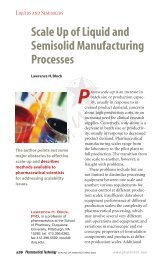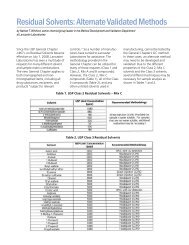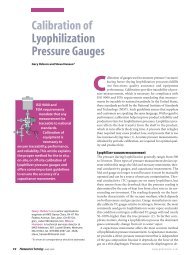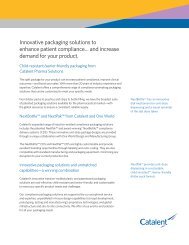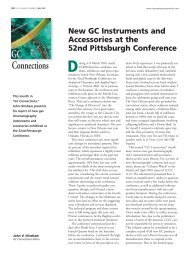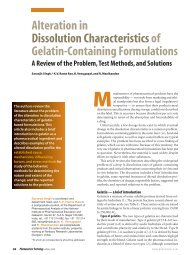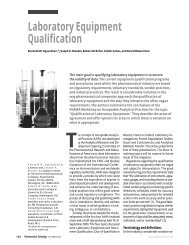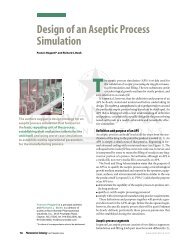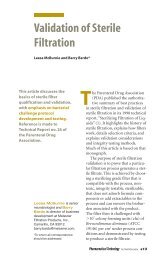Frequently Asked Questions - Pharmaceutical Technology
Frequently Asked Questions - Pharmaceutical Technology
Frequently Asked Questions - Pharmaceutical Technology
Create successful ePaper yourself
Turn your PDF publications into a flip-book with our unique Google optimized e-Paper software.
<strong>Frequently</strong> <strong>Asked</strong> <strong>Questions</strong><br />
5<br />
11. Is drug release from Carbopol ® polymer matrices pH-dependent?<br />
Due to the anionic nature of the polymers, drug release from Carbopol ® polymers matrices may be pH-dependent.<br />
At lower pH values, the polymer is not fully swollen and there are larger regions of microviscosity. The dissolution medium can<br />
penetrate fast and deep into the glassy core and the drug is released faster, before complete gel formation occurs.<br />
As the pH increases, the ionization of the carboxylic acid groups causes maximum swelling, resulting in fewer and smaller regions<br />
of microviscosity. The rapid gel formation acts as a barrier for the release of the drug, thus prolonging the release.<br />
However, Lubrizol has demonstrated that Carbopol ® polymers have the ability to form robust tablets which can extend<br />
drug release in both acid and buffer media. No significant difference has been observed in the release profiles due to<br />
dissolution medium in the case of drugs with pH-independent solubility.<br />
12. Does the acidic nature of Carbopol ® polymer provide any benefit in formulation?<br />
The acidic nature of Carbopol ® polymer can modulate the microenvironmental pH in the tablet. This is important for API stability<br />
and solubility inside the matrix. Control of microenvironmental pH can provide consistent release of cationic drugs throughout the<br />
gastrointestinal tract.<br />
13. Is there a potential for ionic interaction with certain APIs when Carbopol ® polymers are incorporated in a matrix tablet?<br />
Due to their anionic character, Carbopol ® polymers may form ionic complexes with cationic drugs. Carbopol ® polymers are weak<br />
acids (pKa=6 ±0.5). It is important to note that the complex formation is generally reversible as the endogenous cations displace<br />
the drug from the polymer upon administration. The potential for ionic interaction is determined by the API properties (pKa/<br />
alkalinity, steric hindrance and molecular size/shape) and polymer to API molar ratio. Typically, if an ionic interaction occurs, it will<br />
result in slower drug release.<br />
Ionic interaction will not occur with all cationic drugs and is API and formulation dependent.<br />
Examples of commercial products containing cationic APIs and Carbopol ® polymers are tablets of dextromethorphan,<br />
diethylpropion, glucosamine, metformin, metoprolol, and pseudoephedrine.<br />
14. Can Carbopol ® polymers be used as a controlled release excipient in combination with low solubility APIs?<br />
There is a variety of low solubility APIs formulated with Carbopol ® polymers as extended release matrix tablets. Examples of<br />
commercial tablets include nifedipine, lithium carbonate and mesalamine. For this type of API, the predominant in vitro drug<br />
release mechanism from Carbopol ® polymer matrix tablets is polymer relaxation (erosion).<br />
15. What are the potential benefits of a combination matrix (Carbopol ® polymer and hypromellose) vs. use of a single<br />
polymer matrix? Are there other polymer combinations that can be used?<br />
Data demonstrates a synergistic interaction may occur when Carbopol ® polymers are used in combination with hypromellose.<br />
Specifically, a lower total polymer level could be used in a formulation, thus enabling smaller tablet sizes and overall formulation<br />
cost savings. Additionally, more consistent drug release can be achieved. By varying the total polymer level and ratio of the two<br />
polymers it is possible to modulate the drug release profile.<br />
Synergistic use of Carbopol ® polymers with other extended release excipients (hydroxypropyl cellulose, sodium carboxymethyl<br />
cellulose, sodium alginate, polyethylene oxide and methacrylic polymers) has also been reported in the literature.




